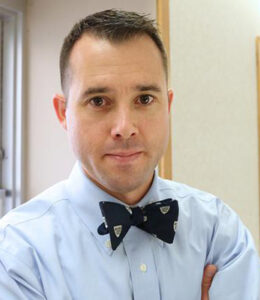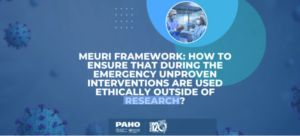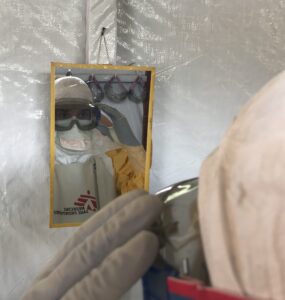This is part two of Dr. Billy Fischer’s interview with Lauren Sauer, MSc, director of the special pathogens research network at NETEC and associate professor at the University of Nebraska Medical Center (UNMC), and Rachel Lookadoo, a public health lawyer and assistant professor at UNMC. Dr. Fischer, a pulmonary critical care physician who directs emerging pathogens efforts through the Institute for Global Health and Infectious Diseases, talks about caring for patients with Ebola, which he describes as a disease of poverty. He also answers questions about the increase in outbreaks, how climate change contributes, and the need to break down the façade of fear. Find the first interview here.
Q: Have you seen advances in the standard of care, or in the way we provide care since that first known outbreak in Zaire in 1976?

Dr. Jean-Jacques Muyembe was the first to discover the virus, leading the design of the first effective treatment and then pioneering vaccines. We’ve learned from his work, as well as those from Emory, Nebraska, and Bellevue, which also took care of patients with Ebola virus disease during the 2013-2016 epidemics. The concept of optimized supportive care particularly advanced with the 2014 epidemic. Patients looked like those that we take care of in Baltimore and Chapel Hill, but the care that they were receiving was vastly different. It was one of isolation, which is effective for preventing transmission but doesn’t do a lot of good for the person who is isolated. The disparity between patients who looked like they had septic shock, and those that were severely ill from sepsis but not getting the care they needed, was a really important divide we had to cross.
Q: It feels like we’re seeing more and more outbreaks of viral hemorrhagic fevers, including two Marburg outbreaks. Do you have any thoughts on why that’s happening?
Not only are we seeing an increase in frequency and outbreaks, we’re seeing an increase in the size of these outbreaks. I’m not sure what’s driving these, but climate change could be changing the range of ‘potential’ reservoirs. The growing disparity in economies could also be a driver, and the locations of these outbreaks are not random. They are occurring in areas that both have the likely reservoir and are incredibly underserved, with inadequate access to health care, protein sources, clean water, and other resources. I also think as deforestation occurs, and the population grows and expands into these environments, we’ll see more cross over events–emerging infectious diseases that originate in animals and have the ability to cross over into human populations. So our charge is preparedness. It’s not just building up resources in the U.S., but also building up access to health care and detection systems globally so that not only do we find these infections, or these crossover events, but that we’re right there to respond and provide people the kind of care you and I would want.
Q: Can you just tell us a little bit about how new vaccines and treatments, and access to medical countermeasures, improves your ability to care for patients?
Yes, this is an important topic because it’s not just about having a drug, or a vaccine, or a good provider. A critical piece for providing good care is having the right structure. The traditional Ebola treatment units we’re accustomed to seeing in pictures from the 2014 epidemic are opaque white tents that housed hundreds of Ebola patients. You aren’t able to see in or out, and can’t monitor patients closely. The cubes were a really good start, and these have evolved to treatment units that have corridors that you can walk down, without PPE, and you’re able to see through plexiglass, to monitor and provide care.

Also having the right providers with the right experience is really critical. Typically, patients with Ebola Virus Disease present five to six days after the onset of symptoms, and that’s largely because the symptoms are so nonspecific that people don’t know they’re infected. And they only present after they don’t get better with treatments like antibiotics or anti-malarial drugs. But any delays in the diagnostics can push these people out of the therapeutic window for medical countermeasures or pathogen specific treatments. Having access to a good laboratory can provide diagnostics, as well as daily chemistry and hematology, that allows us to provide good supportive care.
We also seen the operationalization of therapeutics under two platforms. One is MEURI (Monitored Emergency Use of Unregistered and Investigational Interventions), an ethical protocol developed by the World Health Organization to evaluate the use of experimental drugs in public health emergencies. This is a compassionate care program, when a clinical trial isn’t available but there’s good data support, safety and efficacy of these therapeutics, in these emergency outbreaks with pathogens of high mortality. This has led us to operationalize therapeutics and served as an onramp for randomized clinical trials. The other is the PALM trial, jointly sponsored by the National Institutes of Health (NIH) and the National Institute for Biomedical Research in the Democratic Republic of Congo, which found two treatments that can substantially reduce mortality in patients with Ebola virus disease.
But it’s not the medical countermeasures that stop the outbreaks. It’s the engagement with the affected population. We have to remember how important it is to preserve the traditional practices of people in paying respect to the dead. It’s not the fancy virology, it’s not the fancy meds, it’s really just building trust between communities. And the problem is the only time they see us in these spaces is when there’s an emergency outbreak. What we have to do is shift from these rapid responses to outbreaks into more integrated cycles of preparedness in these areas that are underserved.
Q: How did you get involved in building special pathogen readiness?

I wanted to be an infectious disease doctor my whole life. I was always interested in how infections and particularly viruses affect not only the individual, but their families, communities, healthcare systems, and even economies. I was really fortunate to work under some incredible physicians, including the late CDC Pathologist Dr. Sherif Zaki, and Dr. Steven Nichols, who previously led the special pathogens group at CDC. I worked with them on Lassa Fever and Hantavirus, and when I went to medical school and residency, I was really captivated by the physiology of critically ill individuals, but also not only providing care to that individual who’s incredibly complicated, but also helping the family get through that process. For me, it’s always been natural to focus on severe viral infections as this kind of complement of my interest in infectious diseases, but also critical care medicine, and serendipity brought me back to Ebola and Lassa Fever. But I was not raising my hand saying I will go to these outbreaks to provide care. I got sent to the first Ebola outbreak because I spoke French, and I had experienced living in resource limited settings, particularly in Africa, and I was a critical care physician. That experience changed my life because for the first time I understood how potentially somebody with my background could have an impact. I’ve stuck with it over these past years because I really do see the promise of what we’re doing. The combination of optimized supportive care with pathogen specific therapies, I see the promise of making sure that everybody has access to a single standard of care, the same standard of care that you and I would want if we were expected, I see that promise. And I think that’s what draws me in.
Q: What else do you want people to know about these diseases?
If we can break the facade of fear around these viruses, we will improve our ability to reduce mortality, which ultimately will have another impact downstream of reducing fear. The other thing I want you to take from this is that ultimately, these are diseases of poverty. If we fail to address the things that lead to these outbreaks in the first place, the susceptibility of those environments that allow transmission, then I think we’re going to keep seeing an increasing number, size, and frequency of outbreaks. Our response has to begin with preparing and increasing access to healthcare, increasing access to clean water, increasing access to education, improving the social determinants of health, and addressing the social determinants of health. We also have to engage with adverse communities before the outbreak, including within our own country and state, because that’s where we build the foundation of trust that is required when these outbreaks occur, that allow us to be able to better respond and recover.
The National Emerging Special Pathogens Training and Education Center (NETEC) strives to set the gold standard for special pathogens preparedness and response across health systems in the United States. With the goal of driving best practices, closing knowledge gaps and developing innovative resources, NETEC works alongside and in cooperation with the CDC and is funded by ASPR, the U.S. Department of Health and Human Services Office of the Administration for Strategic Preparedness and Response (ASPR).
The ASPR recently selected UNC to be a Regional Emerging Special Pathogen Treatment Center (RESPTC). This means UNC will become a regional expert in civilian biodefense, joining Emory University, as the only two RESPTCs in the Southeast. William Fischer, MD, and David Wohl, MD, along with UNC colleagues, will lead the new Center funded through the U.S. Department of Health and Human Services’ Administration for Strategic Preparedness and Response (ASPR). Read more.
